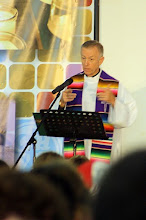

Today’s Memorial (an optional one) was for 3 early Christian martyrs: Nereus, Achilleus and Pancras. The latter died for the Faith at the end of the 3rd century; the other two may have died then, or perhaps the beginning of the 2nd century—we’re not sure. What we are sure of is their tombs, and the churches built over the catacombs where they were buried.
They stood alone against the power of the Roman Empire and its leader, the Emperor Diocletian (and Trajan, if the first two were martyred in the early 2nd century as one source suggests). Their tombs and the churches over them are their trophies of victory. But who would have considered them glorious and “winners” back then?
We fast-forward to the 20th century. In the same spirit as these early martyrs, but even more “alone,” Franz Jägerstätter was a young Austrian who refused to be conscripted into the Nazi army after his home country was over-run by Germany. His was a martyrdom of faith, more “alone” because even the local clergy advised him that to oppose the regime of the Third Reich was pointless. His story was first told movingly by Gordon Zahn in the important book In Solitary Witness. And in a fitting “twist” it was the German pope, Benedict XVI, who declared him a martyr—he was beatified in 2007.
Finally, the three children (from left, Jacinta, Lucia and Francisco) who are celebrated especially on 13 May: the visionaries of Fatima. It is to commemorate the 10th anniversary of their beatification (more on this point in a minute) that Pope Benedict is now making his apostolic visit to Portugal.

They stood alone against the power of the Roman Empire and its leader, the Emperor Diocletian (and Trajan, if the first two were martyred in the early 2nd century as one source suggests). Their tombs and the churches over them are their trophies of victory. But who would have considered them glorious and “winners” back then?
We fast-forward to the 20th century. In the same spirit as these early martyrs, but even more “alone,” Franz Jägerstätter was a young Austrian who refused to be conscripted into the Nazi army after his home country was over-run by Germany. His was a martyrdom of faith, more “alone” because even the local clergy advised him that to oppose the regime of the Third Reich was pointless. His story was first told movingly by Gordon Zahn in the important book In Solitary Witness. And in a fitting “twist” it was the German pope, Benedict XVI, who declared him a martyr—he was beatified in 2007.
Finally, the three children (from left, Jacinta, Lucia and Francisco) who are celebrated especially on 13 May: the visionaries of Fatima. It is to commemorate the 10th anniversary of their beatification (more on this point in a minute) that Pope Benedict is now making his apostolic visit to Portugal.

These children did not stand up to the power of an “Evil Empire” but only to the local government authorities who tried to get them to admit they were making up the story of the Lady. But at ages 9, 9 and 7, a town police chief would seem equally as threatening, especially when he did in fact threaten the children. Lucia (the oldest) long outlived her young cousins (Francisco and Jacinta): they died in the influenza epidemic shortly after World War I, but she lived to age 97, dying in the Carmelite convent where she spent so much of her life. How “alone” must that have felt, I wonder? Beyond that, since she died so recently, Lucia is the one child of the visionaries not beatified. “Left out”? Probably not really…
Glory does not come from fame or praise: it comes from faithful, prayerful love of Christ, in and with and for others. It comes from only one word—that of our Lord, when He says to us, “Well done, good and faithful servant!” (Luke 19:17). May we all hear that word spoken to us in joyful welcome home!

These were ordinary people who became extraordinary by spiritual standards. They, somehow, became imbued with so intense a love for our Lord and his Mother Mary, they gave up their lives on earth. It is so fitting that the internet of our age brings their commitment to our attention. Encouragement by example can work if one is open to risk-taking, Our life's journey falters often; these martyrs did not give in to the secular world of their times. We give praise and thanks for their sacrifices.
ReplyDelete